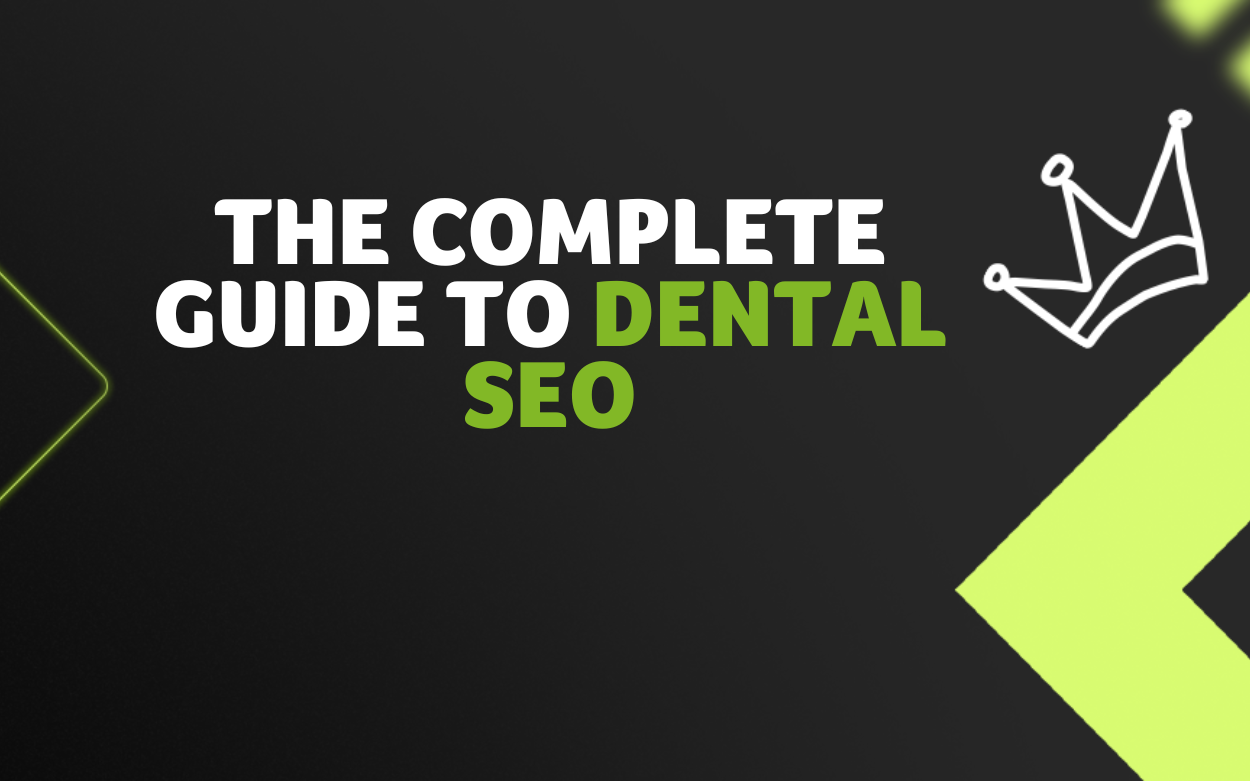
There’s never been a better time for dentists to grow their business.
According to IBIS World, the sector grew by 2.5% per year between 2018 and 2023.
And with 89% of people starting their search for services online, search engine optimization (SEO) is one of the best ways to do this.
This complete guide to dental SEO helps you understand the principles of search engine marketing and how you can start generating new patient inquiries via Google.
What Is Dental SEO Marketing?
Most people already have a dentist. But what if they need a new one—for example, when they move to a new area.
In this case, they’d probably search for a dentist on Google or a similar platform. And, they will most likely click on the dental practices that appear at the top of Google’s search results.
In fact, the top search result gets over 30% of all clicks, while position two gets around 25%. The percentage of clicks continues to decline as you go down the page.
By the time you get to page two, the number of clicks is almost zero.
Dental search engine optimization is the process and techniques involved in ensuring your practice’s website appears in one of these critical top spots for searches that are relevant to your dental services. It is a subsection of your dental practice’s digital marketing strategy.
This helps you draw more traffic to your website—and a proportion of these visitors are likely to get in touch and become patients.
How do search engines choose what to rank first?
To get your dental SEO strategy right, you first need to understand how search engines choose which websites to rank first.
Unfortunately, Google alone has around 200 ranking factors. Understanding all of them takes a long time and probably isn’t worth it to begin with.
Here’s a brief list of the main factors that you should know:
✅ Relevance: Your content and website need to be relevant to the user’s search term.
✅ Authority: Websites for established organizations that are well-respected in their industry are more likely to rank higher for relevant search terms.
✅ Backlinks: This is when one website publishes a hyperlink to another one. The number of backlinks and referring domains pointing to a website contribute to its authority rating.
✅ Page speed: The speed at which a website loads affects the user experience. Search engines want users to have a good experience, so they are more likely to rank websites with good page speed and enhanced technical SEO.
✅ Content quality: Search engines also want to provide users with valuable content that answers their search queries. Therefore, the quality of content is also a critical ranking factor. Good website content is comprehensive, written by experts, based on first-hand experience, and features a wide range of media.
✅ Mobile friendliness: 64% of searches are now performed on mobile devices; therefore, search engines prioritize ranking websites that are optimized for mobile devices.
“But hold on,” I hear you say. “I can get new patients by paying for ads. Why invest in dental SEO?” Let’s look at some of the benefits in more detail.
Why Invest in a Dental SEO Strategy?
SEO tends to be a longer game than most other advertising strategies. However, the time, money, and resources that you invest could result in solid long-term gains.
Here are a few examples:
Excellent return on investment
Get dental SEO right and you can make a lot of money.
As mentioned earlier, patients rarely switch dentists once they have found one they like. But if you manage to attract new patients with a sound SEO strategy, it can be very lucrative.
Let’s calculate the potential return on investment (ROI) you could achieve.
Let’s assume that your dental practice is based in Spokane, WA. Therefore, you decide to target the term “Dentists in Spokane.” We’ll explain more about search terms, their role in your dental SEO strategy, and how to choose which terms to target later on in the article.
Using an SEO tool makes it possible for us to see how many people search for this term each month. We use Ahrefs, but other popular platforms include Moz and Semrush.
A quick look at Ahrefs’ keyword report for “Dentists in Spokane” reveals about 150 monthly searches.
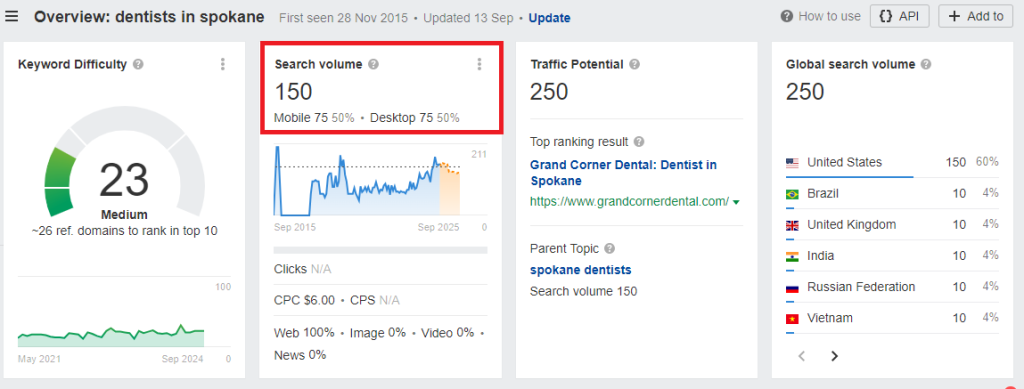
Source: Ahrefs
Let’s assume that you achieve this traffic (the top-ranked result actually gets far more traffic at 250).
We’ll also assume:
- A general customer lifetime value (CLV) of $10,000 per patient.
- A conversion rate of 3%.
That’s 4.5 new patients per month or 54 per year, with a CLV of $540,000!
Build your brand
Direct revenue isn’t the only benefit of dental SEO. It’s also a good way of exposing your brand to potential patients.
For example, the number-one ranking article for “dentists in Spokane” is Grand Corner Dental. They publish regular blog articles that answer common dental questions.
Below is a good example—they explain the difference between dental implants and dentures: 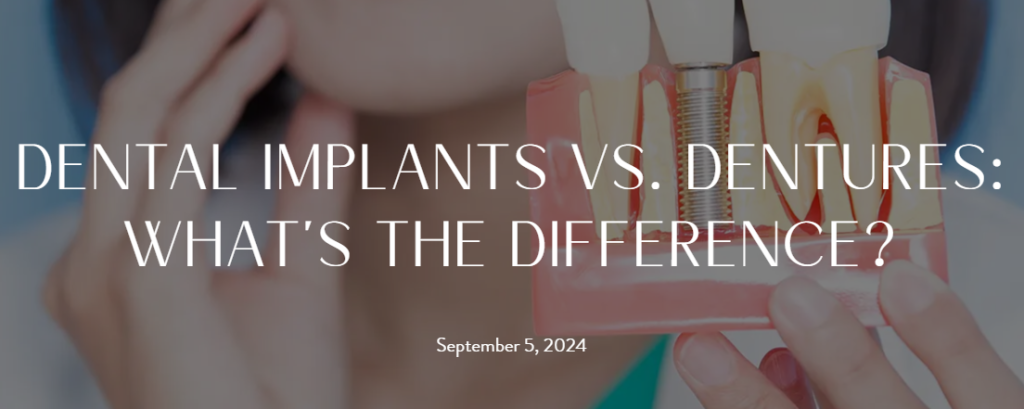
Source: Grand Corner Dental
People who read this may be impressed with their professionalism and knowledge. While they might not become a patient themselves, they could remember the dental practice and recommend it to friends.
Or, if their own dental practice closes, they might remember Grand Corner and become a patient.
Better patient experience
Good dental SEO also has a functional purpose. Google likes to show relevant results to its users, so by targeting keywords that match your practice, you provide a better experience to people.
For example, if you specifically provide orthodontic services to young people at your Spokane practice, then you would target keywords related to relevant search terms. This will help the right people find the right services.
Examples include:
🎯 Braces for teenager
🎯 Teenage malocclusion
🎯 How to fix buck teeth
You can also target branded search terms—in other words, search terms related to your dental practice’s name. This helps patients find your website when they don’t know the exact location.
Examples of this might be:
🎯Grand dentistry
🎯Grand dental care
🎯Grand corner dental contact
Stay ahead of the competition
If your practice appears on page one of Google, but your competitors’ practices don’t, then you’ll have a source of new business that they’re missing out on.
One of the biggest advantages of dental SEO is that the content you publish and the improvements you make often continue driving traffic to your website for months or even years to come.
Usually, you can boost your rankings and maintain your competitive advantage by making regular, incremental dental SEO improvements.
A Step-by-Step Guide to Dental SEO
Now that you know what dental SEO is and the benefits of getting it right, let’s go into detail on the steps you can take to boost your search rankings.
1.Perform keyword research
Keywords are the search terms your potential patients type when searching for a dentist.
Keyword research is the process of understanding which ones you should target to draw the most traffic to your dental practice website.
We’re going to show you how to do it with SEO tool Ahrefs.
Find seed keywords
The first step is to collate as many relevant keywords as possible in a spreadsheet so you can analyze them and decide which ones to target.
Open Ahrefs and visit the Keywords Explorer tool.
Enter seed keywords. These are very broad keywords that apply to your dental practice. These might include:
- Dentist Spokane
- Dentists in Spokane
- Dentist near me
- Dental implants
- Cosmetic dentistry
- Teeth whitening
You can type one search term at a time or you can enter multiple terms. 
If you type in multiple keywords, then you’ll be taken to an overview of the keywords you entered. 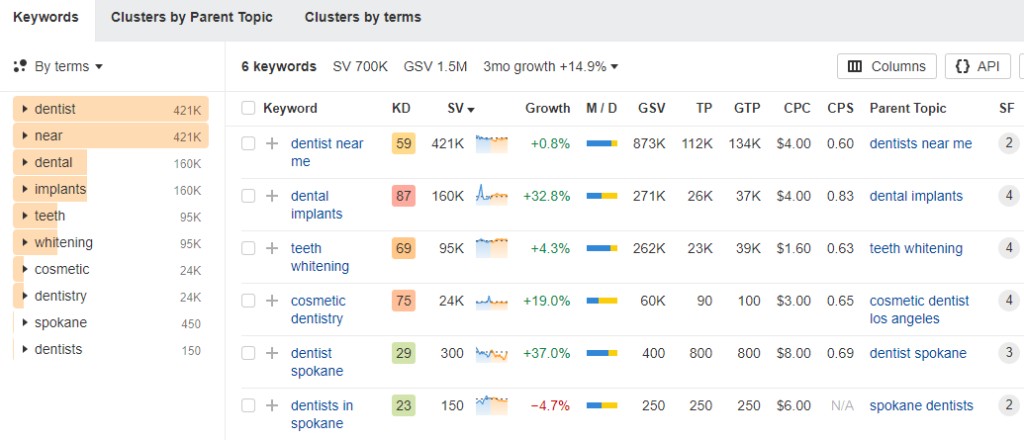
This is useful to see the different parent topics and clusters that are related to your seed keywords. You can use this to find ideas for seed keywords that you might not have considered.
Find long-tail keywords
The next step is to find more specific keywords to add to your list. These are known as long-tail keywords. Long-tail keywords are useful because they tend to be easier to rank for.
That’s because keywords like “dentist near me” are obvious and thousands (if not millions) of dentists will target them.
But not everyone will target keywords like “dentist who specializes in dentures near me”. This might happen because competitors might not think to target it or it might not apply to them.
If you enter a single keyword, then you’ll be taken to a report on that keyword. If not, click on one of the keywords in the overview.
Here, you can see some ideas for keywords:
🔍 Term matches: Keywords that include your target seed keyword.
🔍 Questions: Search queries that are relevant to yours that are phrased as questions.
🔍 Also rank for: A list of similar keywords that other pages featured in the top ten in the search engine results pages (SERPs) also rank for.
🔍 Also talk about: Terms that the top-ten SERP results frequently mention.
🔍 SERP overview: This includes a column highlighting the term that each page in the SERP ranks highest for.
Click “View all” to see a longer, more detailed list. Add any keywords that you think are relevant to your dental practice to your list.
Filter your keywords
Once you have 30-100 keywords, it’s time to prioritize them and decide which ones represent the best dental SEO opportunities.
The aim is to find ones that are:
✅ Relevant to your business and patients.
✅ Easy to rank for.
✅ Get decent volumes of traffic.
You can do this by filtering your list of keywords on the following statistics:
💡 Search volume: This is the most important metric as it gives you the estimated number of monthly searches a search term gets in your region. The more searches a keyword gets, the more potential patients you will attract.
💡 Keyword difficulty: This indicates how hard it is to rank on page one for a search term. It is mainly based on how many links point to the top-10 pages.
💡 Traffic potential: This is an estimation of how much traffic the top-ranking website achieves. Traffic potential measures the combined traffic from all keywords that a page ranks for. This is important because your website won’t just automatically rank for the keyword you target. In fact, it’s possible that you might even rank higher for search terms you didn’t intend.
💡 SERP overview: Scroll down to the bottom of a keyword report to see a SERP report. This gives you details about the websites and pages currently ranking for this term. Once again, this indicates how difficult or easy it will be to rank for the term. 
For example, in the screenshot above, the domain rating (DR) is high for all websites on the SERPs. Most also have a lot of backlinks and high word counts. This means it would likely be very difficult to displace these entries from their respective rankings.
| 🤔 What is domain rating (DR)?
DR is a measurement of a website’s authority on a scale of 1-100. The higher a website’s DR, the more likely it is to rank for relevant search terms. It was created by Ahrefs and is mainly based on the number of backlinks and domains pointing at a website. Other SEO tools have their own version of DR. For example, Moz calls it domain authority (DA). All are calculated slightly differently but generally indicate the same thing. |
Assess your keywords and create a shortlist of ones that provide the most traffic but are easiest to rank for.
You will continue to target these keywords in your dental SEO campaign.
Set up local SEO
Dental services tend to be location-dependent. In other words, one of the most important factors when patients choose a dentist is how close they are to them.
This is reflected in the search queries they use—think popular terms like “dentist near me” or “best dentist in [my town].”
Search engines understand this and treat location-based queries differently. You need to take some steps to ensure your website is optimized for these searches.
For example, if you type in “dentist Spokane,” you’ll see some options for more specific Google search results and some directory listings. 
More importantly, you’ll also see a map and a list of local search results for dental practices nearby. 
Together, this map and list is called “the local map pack.” To ensure your business appears in this section, you need to set up a Google Business Profile.
Set up a Google Business Profile
Formerly known as Google My Business, Google Business Profile allows you to tell the search engine what information to give users about your practice.
By setting up a profile, you’ll increase your visibility on Google, make it easier for patients to learn about your dental products or services, and gain social proof by allowing site visitors to post online reviews.
Google chooses which websites to show in these results based on the following factors:
🎯 Relevance: How well your business matches the user’s search term.
🎯 Distance: How far away you are from the user.
🎯 Prominence: How well-known your business is—which is determined based on factors like how many backlinks your website has.
Here’s how to get set up:
1. Go to Google Maps and click the tab in the top-left corner. Choose “Add your business” from the menu.

2. Create a business account, or sign in to your account if you already have one.
3. Next, choose the relevant business type.
4. Now go through the “Create profile” menus adding information about your:
a. Website
b. Business
c. Its location
d. Services
e.Contact information
f. Opening hours
You can also add photos of your practice and choose to let patients contact you via Google.
Here are some tips to optimize your profile:
💡 Fill out the information comprehensively: The more information you provide, the more likely your practice will appear in searches. Providing more information also helps potential patients find the information they require, encouraging them to opt for your dental products or services.
💡 Keep your business information up-to-date and accurate: This allows patients to find correct information on your practice.
💡 Respond to online reviews: This shows Google and users that your practice is active and cares about patient feedback.
Add your business to relevant directories
Think back to our local dental SEO search in the previous section. The first to come up were links to directories.
Appearing in relevant directories is important for dentists’ local and general SEO. It helps patients find dental practices and shows search engines that they’re real practices that are active.
There are several types of directories that you can appear in, including:
General directories: Think Yelp or Yellow Pages, being directories which any business can register on. They attract hundreds of thousands of visitors each month, so it’s well worth having a presence on them.
Local directories: These directories are dedicated to a specific geographical area. This will help show search engines the areas you cover. A good example is Spokane Local, a directory dedicated to businesses in the city. 
Specialist dentistry directories: These are directories dedicated to helping people find dentists. They could be location-based or they might be general.
Being featured on these directories improves your authority with search engines on the subject of dentistry.
For example, Dentist Directory allows you to search for dentists using your postcode or by clicking a locality. 
Use social proof
Once you’re set up on directories and Google Business Profile, your dental practice should start generating positive reviews and getting ratings.
Start publishing reviews on your home page so people can see that you are trusted by patients and transparent about your feedback.
It also sends trust signals to search engines, making it more likely that they will rank you higher for relevant terms.
Here’s a good example from Washington-based Davoudian Dentistry.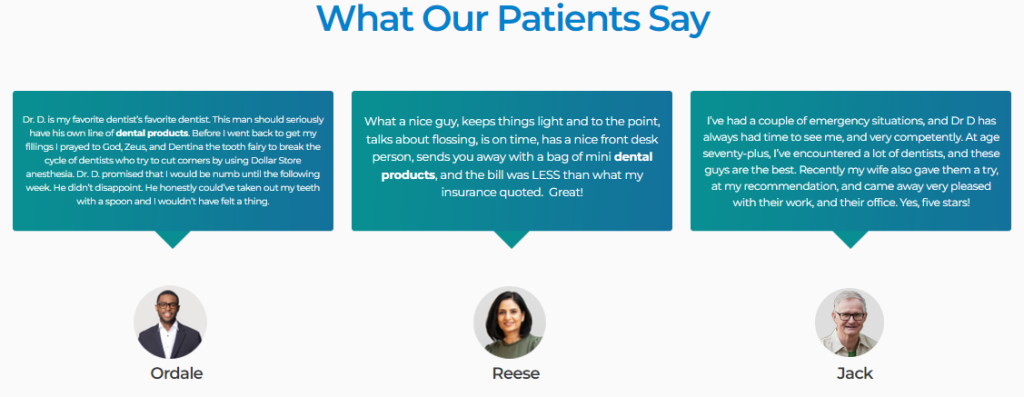
Create content
Content is critical when it comes to SEO for dentists. Regularly posting high-quality website content has several benefits, as it:
Helps you rank for relevant keywords
Think back to the keyword research you performed earlier on in this article.
Some of those dental keywords might have represented prospective patients looking for more information.
If you can answer their questions or provide them with valuable information on dental care, then Google could rank you on page one for some of these questions. This will give you a source of organic traffic and potential new patient leads.
For example, DNA Dental has published an article answering the search query “how to strengthen teeth.” 
Its website ranks number one for the term. This article attracts more than 2,300 monthly visitors—that’s a lot of brand exposure. Some of those visitors will also convert to become patients.
Keeps your dental website up-to-date
Google is more likely to rank websites with fresh content higher than those that haven’t posted anything for a long time.
Faster indexing
Believe it or not, not every web page on the internet can be shown in Google’s search engine results. To appear here, it first needs to be discovered by Google, crawled, and then added to its index.
Crawling is when Google examines the content on your dental website and follows links to other pages and sites. It assesses the content as it goes and decides whether or not to add it to its index.
The more Google crawls your dental website and finds something new, the more often it will crawl it. Essentially it knows that it’s worth visiting because it expects that it might find even more useful content for its users.
By posting content regularly, you ensure new pages on your website get indexed quicker.
Build backlinks
Backlinks are when another website publishes a hyperlink to yours.
They are used as a ranking factor by Google—the more backlinks you have from relevant sources and the more domains that link to you, the higher you are likely to rank.
The reason Google and other search engines use backlinks as a ranking factor is simple. If people online post links to your dental practice’s website, then it indicates that they find your content or business interesting or useful.
There are many link-building techniques, but the best ones for dentists include:
Linkable content
We already mentioned the importance of regularly publishing high-quality content. Another good reason to do this is that it can draw backlinks from people who want to share your dental expertise with others.
For example, in this blog, dietary coaching provider Eating Enlightenment has linked to DNA Dental’s article on teeth discoloration.
This is a good link:
✅ It’s relevant to dentistry.
✅ The website has a medium DR of 43.
✅ The link is included in the content.
But don’t just limit yourself to written content. Think about what else your patients or other people searching for dentistry-related topics might find useful.
These options are called linkable assets and they are a great way to generate links.
Ideas include:
💡 Free tools or apps (think toothbrushing app)
💡 Infographics
💡 Videos
💡 Podcasts
Check out our guide to linkable assets to learn more.
Guest posting
Sometimes known as guest blogging, this is when you write content for someone else’s website.
They get high-quality, expertly written dental content and you get a backlink to your website.
Here’s an example from dentistry website A Tooth Germ. A dentist wrote an article discussing how to deal with anxious patients.
Towards the end of the article, we learn that the author has recently launched a service for such patients and provides a link to their dental website.
A straightforward way to find guest post opportunities for dentists is to use a Google search. Simply type something like:
✅ Guest post
✅ Write for us
✅ Guest author
Along with a term that’s relevant to dentistry. 
For more information, check out the 7 steps we take when choosing guest posting sites.
Digital PR
Another way to build links is to get mentioned in the press. These backlinks are particularly powerful, as search engines trust media sites. They also tend to have very high authority scores.
The challenge is that journalists care deeply about providing their readers with value. They won’t just link to your practice because you ask them to.
Here are some examples of how to earn a PR link:
💡 You’re running an interesting PR campaign.
💡 A journalist wants to quote an expert.
💡 You comment on a relevant story in the news.
Here’s a good example from Wales Online via MSN. A dentist was quoted giving advice to readers.
It’s unlikely that a journalist is going to simply message you out of nowhere. Instead, you’ll have to take action to get on their radar.
Here are your options:
- As mentioned above, launch an interesting campaign. Check out our guide to digital PR for more information on this.
- Reach out to the journalist and start building a relationship with them. We’ve got a section on how to reach out to journalists in this guide.
- Answer journalists’ questions. Platforms like Connectively (formerly known as HARO) connect journalists and bloggers with subject matter experts, enabling them to create well-informed content. If you answer journalists’ questions on dentistry then you will usually be rewarded with a backlink.
Broken link building
A broken link is when the content that a link led to has been moved or removed. The user experiences this as a 404 error.
Broken links represent excellent link-building opportunities. Let’s say a dental association’s website linked to one of your competitors in the past but the link is now broken. You can contact the site owner and suggest your content as a replacement.
Everyone’s a winner. You get a link, the webmaster fixes a broken link, and users enjoy an improved experience.
Improve your on-page optimization
On-page optimization is where you enhance the content on the page and add certain tags. This helps search engines understand what the page is about so they can rank the content for relevant search terms.
Here’s a brief summary of the most common on-page SEO optimization techniques:
Title tags
The title tag is the heading that shows up in search engine results. Keep it short, include the main keyword and describe the page content. Keep it to a maximum of 60 characters or it will get cut off in the search results.
Meta descriptions
The meta description is a short summary that’s displayed beneath the title in search results. It doesn’t directly impact search engine rankings, but it does influence click-through rates.
Write compelling, concise descriptions with a call to action, ideally including the primary keyword. Keep it under 160 characters.
Header tags (H1, H2, H3)
Header tags structure your content, making it easier for both users and search engines to understand the page hierarchy.
Use the H1 tag for the main title and H2/H3 for subheadings. Ensure the primary keyword appears naturally in at least one header.
Keyword optimization
Keywords should naturally appear throughout the content, particularly within the first 100 words, headers, and title tag. Avoid keyword stuffing—in other words, artificially adding keywords in strange places simply to boost your dental SEO—this can lead to Google actually reducing your rankings.
Internal linking
Linking to other relevant pages on your website encourages users to spend more time on your site and supports indexing by enabling Google to navigate your site.
It also helps spread link equity. Using descriptive anchor text that includes relevant keywords helps search engines and users understand the content’s context.
Image optimization
Optimize images by reducing file sizes for faster load times. Use descriptive file names and alt text that include relevant keywords. These help search engines and visually impaired users understand the image content.
URL structure
Ensure URLs are short, descriptive, and include the primary keyword. Avoid long, dynamic URLs that are difficult for users and search engines to understand. A clean URL structure improves usability and can positively affect rankings.
Outbound linking
Outbound links to authoritative sites improve your content’s credibility. Ensure the links are relevant and enhance the user’s understanding of the topic. Too many outbound links can be distracting, so use them sparingly and have them open in new tabs for better UX.
Multimedia (videos or infographics)
Multimedia like videos or infographics can enhance user engagement and improve dwell time. Properly optimize these with descriptive titles and transcripts (for videos), and by ensuring fast load times to avoid slowing down the page.
Readability and formatting
Content should be easy to read and scan. Use short paragraphs, bullet points, and subheadings to break up long text. Ensure your content is written at an appropriate reading level for your target audience, improving user experience and engagement.
Tighten your technical SEO
Technical SEO involves the parts of your dental website that your users may not necessarily see but still impact their performance.
Here’s an overview of technical SEO factors dentists may need to consider:
Mobile responsiveness
Today around 64% of Google searches take place on mobile devices. Google knows this and prioritizes websites that work well on mobile devices. Use responsive design and test your site on various devices.
Page load speed
A fast-loading website improves user experience and is a ranking factor. Use tools like Google PageSpeed Insights to identify slow-loading elements and optimize them.
You can fix page speed issues with techniques like compressing images, enabling browser caching, and minimizing JavaScript and CSS.
Fix broken links
Broken links harm user experience and can negatively affect SEO. Regularly audit your site for broken links and fix or remove them. Use tools like Google Search Console or online broken link checkers to identify and address these issues.
Canonical tags
Canonical tags are used to indicate the preferred version of a web page when duplicate content exists. This helps prevent content duplication issues that can confuse search engines. Add canonical tags to the head section of your HTML to guide search engines.
Schema markup
Schema markup helps search engines understand content better. Implementing schema can increase your site’s visibility with enhanced results like reviews, ratings, or events. Find out more in Google’s guide to structured data.
Sitemaps
Submit an XML sitemap to search engines like Google to help them index your site more efficiently. The sitemap provides a list of URLs for the search engine to crawl, improving your site’s crawlability and ensuring all important pages are indexed.
SSL certification (HTTPS)
Security is a ranking factor for search engines. An SSL certificate (HTTPS) shows that your site encrypts user data and provides a secure browsing experience. Ensure your site uses HTTPS, as users and search engines prefer secure websites.
Breadcrumb navigation
Breadcrumbs are a secondary navigation system that helps users understand their location on your site.
They improve usability and can enhance the way search engines crawl and index your content. Implement breadcrumbs on larger, multilevel websites for better user navigation.
Attract New Patients with Authority Builders’ Dental SEO Services
SEO for dentists is critical to gaining new patients online. But setting up local dental SEO, creating content, building links, and keeping your on-page and technical SEO in top form takes a ton of time and effort.
The easiest way to boost your search rankings is to work with an SEO agency like Authority Builders.
We provide a range of dental SEO services, including:
✅ Guest post writing and placement
✅ And more!
To find out how Authority Builders helps dental practices like yours, book a call today.
